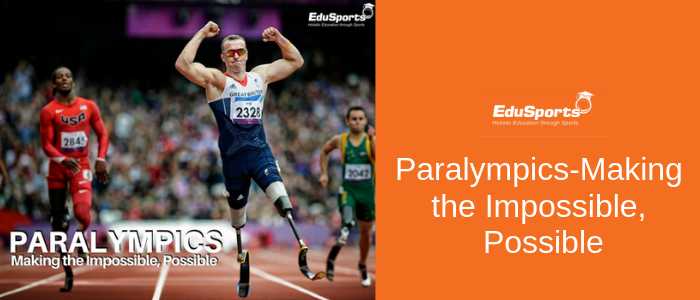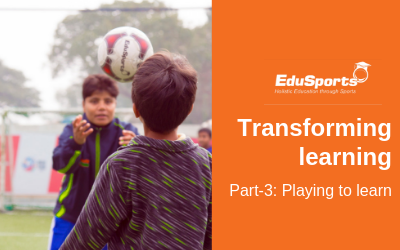“To succeed is to have failed” – learning from failures

Paralympics-Making the Impossible, Possible
The Rio Olympics concluded with its closing ceremony marked by color, music and rain. Many new records were made and new victory styles were created but the most memorable moment was Japan’s Prime Minister Shinzō Abe emerging from a warp pipe dressed as Super Mario and announcing the next Olympics in Tokyo, in 2020.
But it’s not a wrap yet till we conclude the Paralympics- sports for the athletes with impairment.
A History Rundown
The word “Paralympic” derives from the Greek preposition “para” (beside or alongside) and the word “Olympic”. The concept was devised by Sir Ludwig Guttmann, an English neurosurgeon, in 1948 to provide athletic therapy for people in wheelchairs comprising of war veterans and injured civilians. Guttman recognized the value of recreation and sport as a catalyst for rehabilitation therapy and named it Stoke Mandeville Games.
However, it was not until after World War II, that it was widely introduced and the first Paralympic Games were held in 1960 in Rome, Italy.
The first Summer Games of the modern Paralympic era were held in Seoul, South Korea in 1988. With 10,000 attendees, 700 wheel chair dancers and performers, over 950 world records were set. The first winter Games took place in France in 1992. Since then, both Summer and Winter Paralympic Games are held exactly two weeks after the Olympic Games in the same arenas, same tracks and same village.
How did it all shape up?
After the initial identity struggle, the Paralympic Games slowly carved out its own presence with the Agitos- the three swoops in red, green and blue that represent the Paralympic motto “spirit in motion” (instead of the Olympic rings) to inclusion of sports unique to Paralympics like Boccia and Goalball.
The participating athletes produced many iconic heroes with each season, from Trisha Zorn, USA- the most successful Paralympic swimmer with 55 medals (41 gold) to the most recent Paralympic superhero David Weir from UK who won 6 Olympic golds in wheelchair racing in 2008 and 2012. Nicknamed Weirwolf, David said, “It is no longer about disability – it’s about great athletes and great sporting events.” And rightly so because The para- athletes are as agile and performance driven as the Olympic athletes and their sports creates the same euphoria amongst the audience too. Some of the noteworthy sports with a twist are:
Goalball- This game is played by visually impaired athletes, who use blackout masksto ensure equality. Goalball was designed specifically for visually impaired athletes rather than being adapted from an Olympic sport.
Tappers: Standing at each end of the pool, the tapper is a person holding a long pole with a soft circular ball on the end to tap the swimmer as he approaches to indicate that he can move at full pelt without fearing a painful crash at the end.
Guide runners: Blind and partially sighted runners can compete with a guide. Usually tethered to the athlete by a rope, a guide runs with them, acting as their eyes.
India and Paralympic Connection
While we all extol Abhinav Bindra for his gold medal in Beijing, 2008, little do we know about MurlikantPetkar, who had won a gold in 50m freestyle swimming in 1972 Germany Paralympics or Devendra Jhajharia who had won a gold in 2004 Athens Paralympics in the javelin throw event. Devendra is an amputee who set a world record in 2004 which is unbeaten even today and is now gunning for Rio Paralympics.
For the 2016 Summer Paralympic, Indian contingent comprises of 17 participants, slated to be held from 7-18 September in Rio. We have pinned high hopes on our athletes like Ankur Dhama- in 1500 race as a blind athlete, Deepa Malik- in wheelchair shot put, Devendra- in javelin throw and a handful more.
But these para- athletes are already winners in our eyes, fighting against all odds, testing their absolute limits, defying stereotypes and transforming attitudes of the society by breaking down the social barriers and discrimination towards people with impairments. And it does not come easy to them as there aren’t significant facilities for training despite consistent good performances. They also do not get as lucky as the able- bodied athletes in getting jobs, financial- backings or sponsors.
That the Indian para-athletes managed to win 33 medals with 3 golds at the Incheon Para Asian Games, 2014 despite infrastructural and financial problems says enough about their resilience!
Hopes against all odds?
Hopeful promoters like GoSports Foundation are conducting programs and conclaves aimed at improving the sporting ecosystem in India and providing scholarships. Sports icons and stalwarts like Abhinav Bindra, Rahul Dravid and Pullela Gopichand are members of the advisory board of GoSports Foundation. Also, organizations like EduSports have come up in the last few years to bring in a fresh wave of hope- working at the grassroots level to build sports culture among school going children. With age- appropriate Sports and Physical Education curriculum and programs like Adapted Physical Activity (APA) for students with special education needs, EduSports is sowing the seeds of sports culture in Indian schools.
However we definitely need more organizations like GoSports and EduSports to turn the medal tallies around and more importantly to establish the importance and respect that sports deserves.
How does it fare today?
Today the Paralympic Games is one of the largest events in the world for para- athletes with participation spanning 160 countries. More than 4,200 athletes competed in 20 sports at the last concluded London 2012 Games outshining Commonwealth Games’ participation.
Stephen Hawking, the renowned Physicist with ALS said, “Each one has within us the spark of fire, a creative touch,” at the opening ceremony of Barcelona games, 1992. The showcase of world’s elite para- athletes in Rio will soon start with that spark turning it into spectacular firework to be witnessed and cherished forever.
To the incredible and insurmountable para- athletes- let the games begin!
Bibliography
British Paralympians 1960-2014. Available from: https://paralympics.org.uk/games/british-paralympians[Accessed 2 Sept, 2016] David Weir, Paralympic Superhuman. (2012). Available from:https://www.nhs.uk/Livewell/fitness/Pages/david-weir-paralympics.aspx[Accessed 2 Sept, 2016] History of the Paralympics. (2004). Available from:https://news.bbc.co.uk/sport2/hi/other_sports/disability_sport/3628745.stm[Accessed 1 Sept, 2016] Indian Express (2016). Available from:https://indianexpress.com/sports/rio-2016-olympics/expectations-high-from-rio-bound-indian-paralympic-contingent-2972878/ [Accessed 31 Aug, 2016] paralympiceducation.org.au History of the games. Available from: https://www.paralympiceducation.org.au/primary/history-games [Accessed 31 Aug, 2016] Medal Quest- American Athletes and the Paralympic Games. Available from: https://www.pbs.org/wgbh/medal-quest/past-games/ [Accessed 31 Aug, 2016] Pal. S. The Better India- Chasing the gold. (2016) Available from: https://www.thebetterindia.com/66395/blind-ankur-dhama-rio-para-olympics/ [Accessed 1 Sept, 2016] Paralympics- History of the Movement. Available from:https://www.paralympic.org/the-ipc/history-of-the-movement [Accessed 31 Aug, 2016] Paralympics: 10 things you need to know. (2012). Available from:https://www.bbc.com/news/magazine-19341500 [Accessed 1 Sept, 2016] Telegraph. (2016). Available from:https://www.telegraph.co.uk/news/2016/05/29/david-weir-makes-history-as-he-becomes-first-wheelchair-racer-to/ [Accessed 2 Sept, 2016] The History of the Paralympic Movement. Available from: https://www.insidethegames.biz/history/paralympics/the-paralympic-movement [Accessed 1 Sept, 2016]






